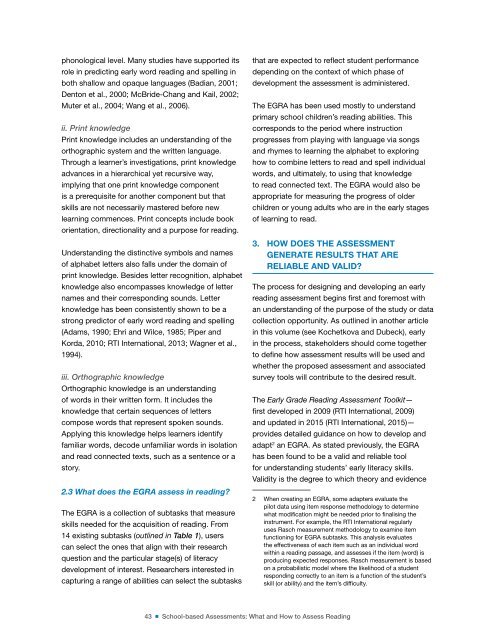UNDERSTANDING WHAT WORKS IN ORAL READING ASSESSMENTS
MZhk301yPHZ
MZhk301yPHZ
Create successful ePaper yourself
Turn your PDF publications into a flip-book with our unique Google optimized e-Paper software.
phonological level. Many studies have supported its<br />
role in predicting early word reading and spelling in<br />
both shallow and opaque languages (Badian, 2001;<br />
Denton et al., 2000; McBride-Chang and Kail, 2002;<br />
Muter et al., 2004; Wang et al., 2006).<br />
ii. Print knowledge<br />
Print knowledge includes an understanding of the<br />
orthographic system and the written language.<br />
Through a learner’s investigations, print knowledge<br />
advances in a hierarchical yet recursive way,<br />
implying that one print knowledge component<br />
is a prerequisite for another component but that<br />
skills are not necessarily mastered before new<br />
learning commences. Print concepts include book<br />
orientation, directionality and a purpose for reading.<br />
Understanding the distinctive symbols and names<br />
of alphabet letters also falls under the domain of<br />
print knowledge. Besides letter recognition, alphabet<br />
knowledge also encompasses knowledge of letter<br />
names and their corresponding sounds. Letter<br />
knowledge has been consistently shown to be a<br />
strong predictor of early word reading and spelling<br />
(Adams, 1990; Ehri and Wilce, 1985; Piper and<br />
Korda, 2010; RTI International, 2013; Wagner et al.,<br />
1994).<br />
iii. Orthographic knowledge<br />
Orthographic knowledge is an understanding<br />
of words in their written form. It includes the<br />
knowledge that certain sequences of letters<br />
compose words that represent spoken sounds.<br />
Applying this knowledge helps learners identify<br />
familiar words, decode unfamiliar words in isolation<br />
and read connected texts, such as a sentence or a<br />
story.<br />
2.3 What does the EGRA assess in reading?<br />
The EGRA is a collection of subtasks that measure<br />
skills needed for the acquisition of reading. From<br />
14 existing subtasks (outlined in Table 1), users<br />
can select the ones that align with their research<br />
question and the particular stage(s) of literacy<br />
development of interest. Researchers interested in<br />
capturing a range of abilities can select the subtasks<br />
that are expected to reflect student performance<br />
depending on the context of which phase of<br />
development the assessment is administered.<br />
The EGRA has been used mostly to understand<br />
primary school children’s reading abilities. This<br />
corresponds to the period where instruction<br />
progresses from playing with language via songs<br />
and rhymes to learning the alphabet to exploring<br />
how to combine letters to read and spell individual<br />
words, and ultimately, to using that knowledge<br />
to read connected text. The EGRA would also be<br />
appropriate for measuring the progress of older<br />
children or young adults who are in the early stages<br />
of learning to read.<br />
3. HOW DOES THE ASSESSMENT<br />
GENERATE RESULTS THAT ARE<br />
RELIABLE AND VALID?<br />
The process for designing and developing an early<br />
reading assessment begins first and foremost with<br />
an understanding of the purpose of the study or data<br />
collection opportunity. As outlined in another article<br />
in this volume (see Kochetkova and Dubeck), early<br />
in the process, stakeholders should come together<br />
to define how assessment results will be used and<br />
whether the proposed assessment and associated<br />
survey tools will contribute to the desired result.<br />
The Early Grade Reading Assessment Toolkit—<br />
first developed in 2009 (RTI International, 2009)<br />
and updated in 2015 (RTI International, 2015)—<br />
provides detailed guidance on how to develop and<br />
adapt 2 an EGRA. As stated previously, the EGRA<br />
has been found to be a valid and reliable tool<br />
for understanding students’ early literacy skills.<br />
Validity is the degree to which theory and evidence<br />
2 When creating an EGRA, some adapters evaluate the<br />
pilot data using item response methodology to determine<br />
what modification might be needed prior to finalising the<br />
instrument. For example, the RTI International regularly<br />
uses Rasch measurement methodology to examine item<br />
functioning for EGRA subtasks. This analysis evaluates<br />
the effectiveness of each item such as an individual word<br />
within a reading passage, and assesses if the item (word) is<br />
producing expected responses. Rasch measurement is based<br />
on a probabilistic model where the likelihood of a student<br />
responding correctly to an item is a function of the student’s<br />
skill (or ability) and the item’s difficulty.<br />
43 ■ School-based Assessments: What and How to Assess Reading



